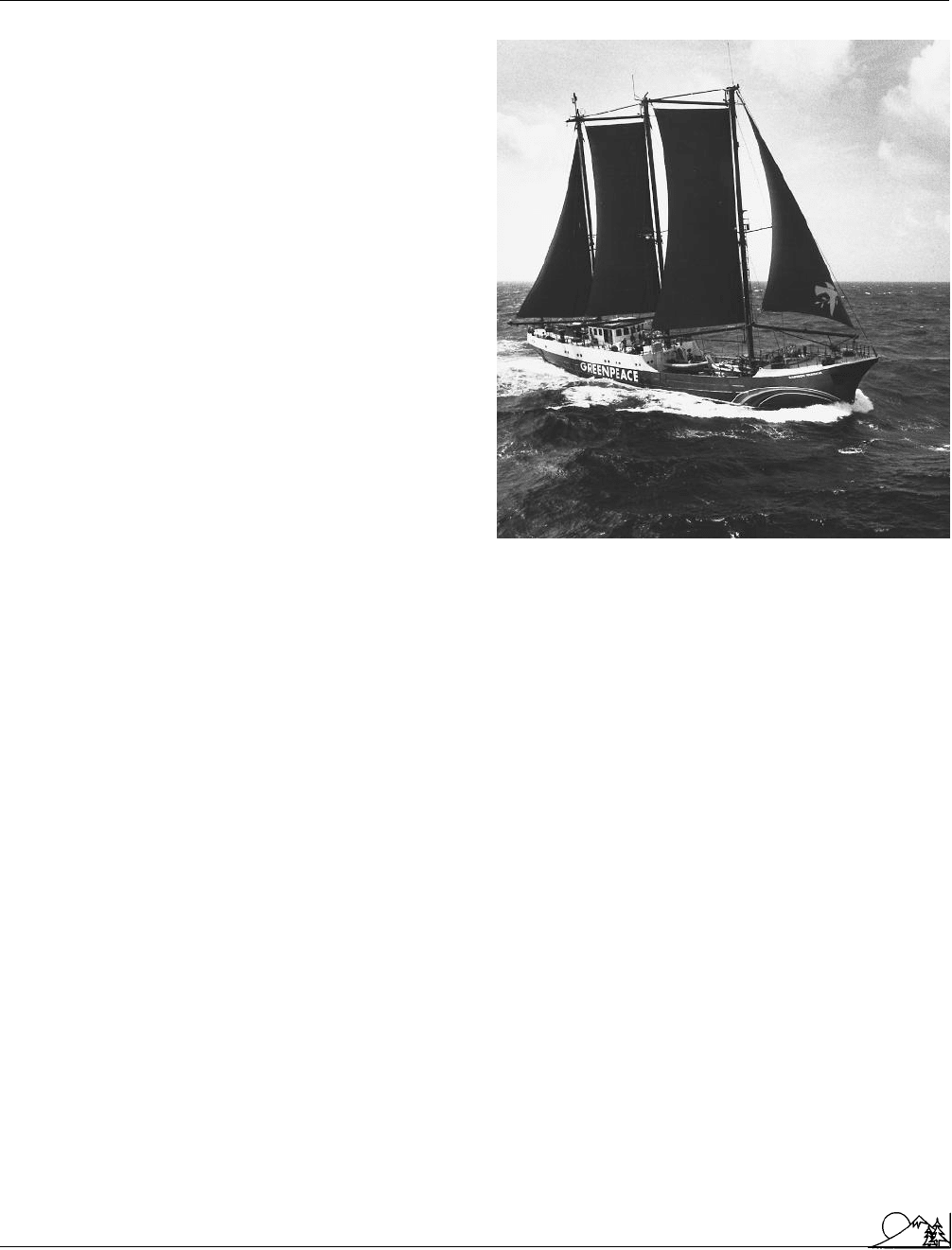Environmental Encyclopedia
Подождите немного. Документ загружается.


Environmental Encyclopedia 3
Green politics
controversies that can impair the development of policies
that would achieve balanced levels of environmental protec-
tion. Single-issue policies often result in regulation through
short-term objectives and standards that focus on individual
issues, such as the concentrations of particular
chemicals
,
or the abundances of certain species. This can result in
actions that focus on compliance with narrow regulatory
criteria, rather than the more comprehensive, longer-term
environmental goals that are pursued by green plans.
Green plans can be implemented by agencies of gov-
ernment at all levels (that is, federal, state or provincial,
county, and city or town), and by companies of any size.
Green plans can be designed by any of these organizations,
but this is done in close consultation with the public, non-
governmental organizations, and environmental specialists.
In fact, multi-sectoral and multi-organizational discussions
are one of the most important aspects of green plans. This
process allows a broad degree of understanding to be reached
among the spectrum of interest groups, allowing green plans
to bridge political and ideological differences concerning
environmental issues.
Green plans have already been implemented by the na-
tional governments of Canada, the Netherlands, New
Zealand, and Singapore. Green plans are also being developed
or seriously considered by the national governments of Aus-
tria, Denmark, Germany, Norway, Sweden, and the United
Kingdom, and by the European Community as a whole. In
addition, many state and provincial governments, municipali-
ties, and companies in some of those countries have imple-
mented green plans. Non-governmental environmental orga-
nizations are also advocating that green plans be designed by
federal and state governments and companies in the United
States. Unfortunately, significant actions in this regard have
not yet been undertaken in that country. It is likely, however,
that green plans will also be developed in the United States,
once their benefits become more broadly recognized.
[Bill Freedman Ph.D.]
R
ESOURCES
B
OOKS
Johnson, H. D. Green Plans. Greenprint for Sustainability. Lincoln, NB:
University of Nebraska Press, 1995.
O
THER
“A Green Plan Primer.” Green Plan Center. May 1997 [cited July 2002].
<http://www.rri.org/gparchive/gp-primer.html>.
Green politics
Green Politics is a relatively recent political movement that
places a concern for
nature
and its myriad
species
at the
667
top of its agenda. New social and political movements arise
in response to crises that are perceived to be both long-term
and
systemic
. The crisis out of which the broadly based
Green movement has emerged is the environmental crisis,
which is actually a series of interconnected crises caused by
population growth
, air and
water pollution
, the destruc-
tion of the tropical and temperate rain forests, the rapid
extinction
of entire species of plants and animals, the
green-
house effect
,
acid rain
,
ozone layer depletion
, and other
now familiar instances of
environmental degradation
.
Many are by-products of technological innovations, such as
the internal
combustion
engine. But the causes of these
environmental crises are not only technological but are also
broadly cultural and political. They stem from beliefs and
attitudes that place human beings above or apart from nature.
Despite their differences, the major mainstream political
perspectives–liberalism, socialism, and conservatism—are
alike in viewing nature as either a hostile force to be con-
quered or a resource base to be exploited for human purposes.
All, in short, share an anthropocentric, or human-cen-
tered, bias.
Against these views, the modern environmental or
Green movement counterpoises its own perspective. Many
Greens
prefer not to call their perspective a political ideol-
ogy, but an environmental ethic. Earlier ecological thinkers,
such as
Aldo Leopold
, spoke of a “land ethic.” Others, such
as Christopher stone, speak of an ethic with the earth itself
at its center, while still others, such as Hans Jonas, speak of
an emerging “planetary ethic.” Despite differences of accent
and emphasis, however, all are alike in several important
respects. An environmental or Ecological ethics, they say,
would include several key features. First, such an ethic would
emphasize the web of interconnections and mutual depen-
dence within which we and other species live. From the this
recognition of interconnectedness a second feature follows:
a respect for all life, however humble humans may believe
it to be, because the fate of our species is tied in with theirs.
And since life requires certain conditions to sustain it, the
third feature follows: we have an obligation to respect and
care for the conditions that nurture and sustain life in its
myriad forms. Since nature nourishes her creatures within
a complex web of interconnected conditions, to damage one
part of this life-sustaining web is to damage the others,
and to endanger the existence of the creatures that depend
upon it.
Green thinkers hold that the enormous power that
humans have over nature imposes on our species a special
responsibility for restraining our reach and using our power
wisely and well. Greens point out that the fate of the earth
and all its creatures now depends, to an unprecedented de-
gree, on human decisions and actions. For not only do we
depend on nature, but nature depends on our care and re-

Environmental Encyclopedia 3
Green politics
straint and forbearance. Humans have the nuclear means to
destroy in mere minutes the earth’s inhabitants and the
ecosystems that sustain them. From this emerges a fourth
feature of a “green” political perspective: Greens must oppose
militarism and work for peace.
But the earth is in danger not only from global thermo-
nuclear war but from the slower destruction of the natural
environment
. Such destruction is a consequence not only
of large-scale policies but of small-scale, everyday acts. And
each of us bears full responsibility for our actions and also,
since we live in a democracy, some share of responsibility
for cumulative effects and collective outcomes. Each of us
has, or can have, a hand in making the laws under which
we live. It is for this reason that Greens give equal emphasis
to our collective and individual responsibility for protecting
the environment that protects us. The fifth feature of the
Green political perspective, then, is to emphasize the impor-
tance of informed and active democratic citizenship at the
grass-roots level. Hence the Green adage, “Think globally
and act locally.”
On this much most Greens agree. But there are also
a number of unresolved differences of approach, emphasis,
and political strategy. The internal ideological spectrum
ranges from “light green” conservationists to “dark green”
radicals, and includes assorted anarchist beliefs,
deep ecol-
ogy
,
ecofeminism
,
social ecology
,
bioregionalism
, New
Age Gaia worship, and other groupings, each differing in
various ways form the others. Among these are differences
regarding the basic beliefs underlying and motivating the
green movement. Some New Age Greens envision an envi-
ronmental ethic grounded in spiritual or religious values.
We should, they say, look upon the earth as a benevolent
and kindly deity—the goddess Gaia (from the Greek word
for “earth")—to be worshiped in reverence and awe. In this
way we can liberate ourselves from the restrictive rationalism
that characterizes modern science. Other Greens disapprove
of such a spiritual or religious orientation, contending that
such beliefs are politically pernicious and inimical to the
rational scientific thinking required to diagnose and solve
environmental problems.
Other differences have to do with the political strate-
gies and tactics to be employed by the environmental move-
ment. Some say that Greens should take an active part in
electoral politics, perhaps even following the lead of Greens
in Germany and organizing a Green Party. Aware of the
formidable obstacles facing minority third parties, most have
favored other strategies, such as working within existing
mainstream parties (especially the Democratic Party in the
United States), or hiring lobbyists to influence legislation.
Still other Greens favor working outside of traditional inter-
est group politics, believing the earth and its inhabitants
hardly constitute a special interest. Others, such as social
668
ecologists, tend to favor local, grass-roots campaigns which
involve neighbors, friends, and fellow citizens in efforts to
protect the environment. Some social ecologists are anar-
chists who see the state and its pro-business and pro-growth
policies as the problem, rather than the solution, and seek its
eventual replacement by a decentralized system of communes
and cooperatives. Greens of the “bioregionalist” persuasion
add that such social and political organization ought to be
based on biological or natural, rather than artificial or politi-
cal, boundaries and regions.
Although all Greens agree on the importance of in-
forming and educating the public, they disagree as to how
this might best be done. Some groups, such as
Greenpeace
,
favor dramatic direct action calculated to make headlines
and capture public attention. Even more militant groups,
such as the Sea Shepherd Society and
Earth First!
, have
advocated
monkey-wrenching
as a morally justifiable
means of publicizing and protesting practices destructive of
the natural environment.
Such militant tactics are decried by moderate or main-
stream groups, which tend to favor subtle, low-key efforts to
influence legislation and inform the public on environmental
matters. The
Sierra Club
, for example, lobbies Congress
and state legislatures to pass environmental legislation. It
also publishes books and produces films and videos about a
wide variety of environmental issues. Similar strategies are
followed by other groups, such as the
Environmental De-
fense
Fund. Another group,
The Nature Conservancy
,
solicits funds to buy land for nature preserves.
Differences over strategy and tactics are, however, dif-
ferences about means and not necessarily about basic as-
sumptions and ends. Despite their political differences,
Greens are alike in assuming that all things are connected—
ecology is, after all, the study of interconnections—and they
agree that complex ecosystems and the myriad life-forms
they sustain are valuable and worthy of protection by political
and other means. See also Abbey, Edward; Bioregional Proj-
ect; Bookchin, Murray; Brower, David Ross; Environmental
attitudes/values; Environmental Defense Fund; Foreman,
Dave; Green advertising and marketing; Green products;
Sea Shepherd Society; Sierra Club
[Terence Ball]
R
ESOURCES
B
OOKS
Bahro, R. Building the Green Movement. London: G.R.P., 1978.
Biehl, J. Rethinking Ecofeminist Politics. Boston: South End Press, 1991.
Bookchin, M. The Modern Crisis. Philadelphia: New Society Publishers,
1986.
Capra, F., and C. Spritnak. Green Politics. New York: Dutton, 1984.
Foreman, D. Confessions of an Eco-Warrior. New York: Harmony Books,
1991.

Environmental Encyclopedia 3
Green Seal
Jonas, H. The Imperative of Responsibility. Chicago: University of Chicago
Press, 1984.
Leopold, A. The Sand County Almanac. New York: Oxford University
Press, 1948.
Manes, C. Green Rage: Radical Environmentalism and the Unmaking of
Civilization. Boston: Little Brown, 1990.
Milbrath, L. W. Envisioning a Sustainable Society. Albany: State University
of New York Press, 1989.
Paehlke, R. Environmentalism and the Future of Progressive Politics. New
Haven, CT: Yale University Press, 1989.
Porritt, J. Seeing Green: The Politics of Ecology Explained. Oxford: Basil
Blackwell, 1984.
Seed, J., et al. Thinking Like a Mountain. Philadelphia: New Society Publish-
ers, 1988.
Worster, D. Nature’s Economy: A History of Ecological Ideas. Cambridge:
Cambridge University Press, 1977.
Green products
Some companies have thrived by marketing product lines
as environmentally correct or “green.” A prime example is
Body Shop, a cosmetics company that is strongly and explic-
itly pro-environment with regard to its products. It strives,
for instance, to develop products made with substances de-
rived from threatened tropical rain forests so that they can
be preserved.
The American ice cream manufacturer, Ben and Jer-
ry’s, has adopted a similar approach to using
rain forest
products in what it sells. Mercury- and cadmium-free batter-
ies have been marketed by Varta, a German company.
Ecover, a small Belgian company, made major sales gains
when it began to market a line of phosphate-free
deter-
gents
. Wal-Mart is another company that provides its cus-
tomers with green products. Loblaw, a Canadian grocery
chain, has introduced a “green-line” of environmentally-
friendly products and has sold more than twice the amount
than it had initially projected. Seventh Generation, a mail-
order company based in California, has successfully marketed
its own line of recycled toilet paper,
biodegradable
soaps
and cleansers, and phosphate-free laundry and dishwashing
detergent.
Many factors comprise a green product. The product
has to be made with the fewest raw materials and produced
with the least amount of contaminants released into the
environment
and with the smallest effect on human health.
Consideration must also be given to how consumers
will use the product and how they will dispose of it when
they are finished. To reduce its waste potential, a product
must often last a significant amount of time or be reusable
or recyclable.
As consumers become more aware of environmental
issues, they will likely look to producers and governments
to provide more products that will permit them to maintain
669
a life-style that is less harmful to the environment. Therefore,
the very nature of products will have to change. They will
have to be lighter, smaller, and more durable so that they
can consume fewer resources in their production and use
and take up less space when they are disposed of.
Ultimately, a real revolution in the use of green prod-
ucts would mean replacing or substantially modifying virtu-
ally the capital stock of society—appliances, automobiles,
housing, highways, etc.—with a different type of product.
In contrast to old smokestack industries, new technologies
and emerging industries—such as telecommunications,
computers, and information—should be able to offer prod-
ucts that are less environmentally harmful. They should be
able to produce many new types of green products and
modify existing products so that they are less damaging to
the environment.
[Alfred A. Marcus]
R
ESOURCES
B
OOKS
Buchholz, R., A. Marcus, and J. Post. Managing Environmental Issues.
Englewood Cliffs, NJ: Prentice-Hall, 1992.
Cairncross, F. Costing the Earth. Boston: Harvard Business School Press,
1992.
Green revolution
see
Agricultural revolution; Borlaug,
Norman E.; Consultative Group on
International Agricultural Research
Green Seal
An independent, non-profit group that encourages the pro-
duction and sale of consumer products that are environmen-
tally responsible, Green Seal allows the use of its certification
mark on products that meet its strict environmental stan-
dards. The mark has a green check over a blue globe.
A growing number of people are becoming aware that
consumer demand for certain products causes great harm to
the
environment
and provides an economic incentive for
activities that damage the planet. Some examples are prod-
ucts that contain
chemicals
such as
chlorofluorocarbons
(CFCs), which deplete the earth’s protective
ozone
layer;
mahogany and other kinds of wood from rapidly-disap-
pearing tropical rain forests; fur coats made from rare and
endangered species
; tuna caught using techniques that kill
dolphins
; and products that waste energy or water, are over-
packaged, cannot be recycled, or are harmful when dis-
posed of.

Environmental Encyclopedia 3
Green taxes
Green Seal symbol. (Photograph by Tom Pantages.
Reproduced by permission.)
By avoiding these products and buying those that do
not cause harm to
wildlife
or degrade the environment,
consumers can encourage corporations to make and sell
goods that are environmentally responsible. With the pub-
lic’s growing commitment to protecting the environment,
store shelves are now full of products that claim to be earth
friendly, environmentally friendly, recycled,
biodegrad-
able
, natural, organic, or are labeled in such a way as to
take advantage of
green advertising and marketing
.
The Green Seal certification mark helps consumers
choose those products that actually are less harmful to the
planet and are not simply marketed in a clever way. Green
Seal uses the highly respected Underwriters Laboratory (UL)
for most of its product testing and certification. Through
its certification process and its educational activities, Green
Seal encourages people to think about how they can help
protect the environment in their everyday activities and their
daily lives.
Green Seal points out that its research shows that four
out of five consumers are more likely to buy a product
with its certification mark when choosing between similar
products. A Gallup survey found that the Green Seal certifi-
cation would have more impact on consumers than would
government guidelines. Thus, consumers, guided by Green
Seal, have the opportunity to influence the actions of major
670
corporations and their impact on the environment through
their purchasing decisions.
Green Seal is headed by Arthur B. Weissman, who
serves as its President and Chief Executive Officer. Its Chair-
man of the Board is Denis Hayes, the well-known environ-
mentalist and
solar energy
advocate who organized the
1970 and 1990
Earth Day
celebrations.
[Lewis G. Regenstein]
R
ESOURCES
O
RGANIZATIONS
Green Seal, 1001 Connecticut Avenue, NW, Suite 827, Washington, D.C.
USA 20036-5525 (202) 872-6400, Fax: (202) 872-4324, Email:
greenseal@greenseal.org, <http://www.greenseal.org>
Green taxes
The search for alternatives to legislation and enforcement of
environmental policy
led a 1988 bipartisan Congressional
study group (Project 88) to call for the use of market forces,
including taxes, to protect the
environment
. Project 88’s
advocacy of these “green” taxes and other economic incen-
tives for reducing
pollution
is actually an old idea. Charles
Schultze, chairman of the Council of Economic Advisers
under President Jimmy Carter, maintained in the 1976 God-
kin Lectures delivered at Harvard University (later published
as a book titled The Public Use of the Private Interest) that
detailed laws and bureaucratic requirements were a costly
and ineffective way to control pollution. Instead, reliance
should be placed on taxes and subsidies that would make
private interests more congruent with public goals.
The economists’ argument, posed by Project 88,
Schultze, and others, is that the harm pollution causes to
health, property, and aesthetics is not paid for by business.
Industries have no reason to consider this harm in their
production decisions. By taxing pollution, the government
would make polluters pay for the damage they inflict. Exter-
nal production costs would be incorporated into ordinary
production decisions. This would correct a market defect
and the market would become more efficient. Green taxes
would not lower environmental standards; they would pro-
vide more protection at the same level of expenditure, or
the same protection with less money.
The present regulatory system is expensive and ineffi-
cient. The amount of litigation is excessive, and relations
between business and government suffer. The uniform stan-
dards often do not make sense, because different companies
have different removal costs depending on their production
process and other factors. For example, a study in the St.
Louis area found that removing a ton of
particulate
matter

Environmental Encyclopedia 3
Greenhouse effect
from a paper factory cost $4, while removing the same mate-
rial from a brewery cost $600.
Industries that can easily reduce pollution should be
encouraged to go beyond the standard and not stop at mere
compliance. Businesses for whom pollution reduction is a
great burden should be able to pay a fine equivalent to the
damage caused. To impose the same requirements on all
businesses regardless of cost is unfair. Moreover, regulations
do not permit pollution-reducing experiments. Companies
should be allowed to choose the lowest-cost method whether
it means treating wastes, modifying production processes,
substituting less-polluting raw materials, or other innova-
tions. By shifting away from uniform standards, pollution-
control costs can be cut drastically. According to one study,
an equivalent
air quality
can be achieved at 10 percent of
existing costs.
Why have governments been so slow to implement
green taxes? The primary reason is because taxes have never
been popular with legislators or their constituents. Nor do
interest groups support them. Businesses prefer court delays
and lobbyists, to the certainty of taxes. Environmentalists
argue that pollution must be eliminated and that companies
should not be given the right to pollute for a fee. Bureaucrats,
moreover, have been comfortable with the existing system.
Pollution-tax proposals proposed by Presidents Lyndon
Johnson and Richard Nixon were almost immediately dis-
missed.
During the Clinton administration there was new in-
terest and support for pollution tax proposals. However,
the necessary Congressional support did not materialize.
Moreover, industry spokespersons and lobbyists promoted
the idea that definitive scientific proof for global warming
had yet to be established.
However, in 2002, during the Bush administration,
which had previously stated that there was not enough evi-
dence to link industrial emissions to global warming, the
Environmental Protection Agency
released a report that
endorsed what many scientists had argued, i.e., that oil refin-
ery,
power plants
, and auto emissions were important
causes of global warming. In 2001, President Bush had
caused international outrage when he said that he would
not join other nations in ratifying the Kyoto Protocol, a
United Nations plan to cut emissions of green house gases,
because he claimed it would be too costly to the American
economy.
Yet by 2002 at least nine European nations had imple-
mented environmental taxes as a means of reducing air pol-
lutants, the growing shortage of
landfill
space, and to pro-
mote the
conservation
of water and electricity. But in spite
of the growing concern over global warming and pollution,
efforts to implement environmental taxes have not found
the needed support in this country due in large part to a
671
general anti-tax sentiment. At this point there still remains
a majority interest in preserving the status quo as opposed
to addressing needed environmental concerns through such
measures as environmental tax reform. With the growing
body of evidence supporting the need for action, and pressure
from other nations, that sentiment may change in the future.
However, the issue at that time will more likely be whether
or not it is too little reform, too late. See also Corporate
Average Fuel Efficiency Standards; Environmental econom-
ics; Externality; Internalizing costs; Pollution control; Pollu-
tion control costs and benefits
[Bill Asenjo Ph.D.]
R
ESOURCES
P
ERIODICALS
Franz, D. “The Environmental Tax Shift.” E/The Environmental Magazine,
May 10, 2002.
———, and B. W. Whitehead. “Dealing With Pollution: Market-Based
Incentives for Environmental Protection.” Environment 34 (September
1992): 7–42.
O
THER
Stavins, R. N., ed. Project 88—Harnessing Market Forces to Protect the
Environment. A Public Policy Study Sponsored by Senator Timothy E.
Wirth and Senator John Heinz. Washington, DC: U.S. Government Print-
ing Office, 1988.
Greenhouse effect
The greenhouse effect is a natural phenomenon that traps
radiation within the earth’s
atmosphere
. Natural
green-
house gases
include water vapor,
carbon dioxide
,
nitrous
oxide
,
methane
, and
ozone
, all essential to support life.
The enhanced greenhouse effect, the direct result of human
activities, increases concentrations of these gases in the atmo-
sphere, and leads to
pollution
of the lower atmosphere and
contributes to global warming. These gases let in sunlight
but tend to insulate Earth against the loss of heat, as do the
glass walls of a greenhouse. A higher concentration of the
greenhouse gases means a warmer
climate
. For example,
the twentieth century was been 1° warmer on worldwide
average than the nineteenth century—warming at a rate 20
times faster than average.
Carbon
dioxide (CO
2
) is considered the predominant
greenhouse gas and has the greatest impact on global heat.
From April 1958, when monthly measurements of CO
2
from atop the Mauna Loa
volcano
began, through June
1991, the CO
2
concentration in
parts per million
went
from 316 ppm to almost 360 ppm. The peak concentration
is due to the destruction of tropical rain forests and the
burning of
fossil fuels
, which accounts for half of the green-
house gases added to the atmosphere. CO
2
is dumped into

Environmental Encyclopedia 3
Greenhouse effect
the atmosphere at a much faster rate than it can be withdrawn
or absorbed by the oceans or living things in the
biosphere
;
since 1765, its presence in the atmosphere has increased by
over 27%. CO
2
buildup in the next few decades to centuries
could be one of the principal controlling factors of the near-
future climate.
Methane, another greenhouse gas, is produced when
oxygen is not freely available and bacteria have access to
organic matter, such as in swamps, bogs, rice paddies and
moist soils. Methane also is produced in the guts of termites
and cows, in
garbage
dumps, landfills, emissions from
coal
mining,
natural gas
production and distribution, and
changing
land use
. Methane concentrations have increased
over 100% since 1765.
Nitrous oxide concentrations have increased in recent
years due to
fertilizer
use and chemical production, such as
in the manufacture of nylon. Nitrous oxide is also dispersed
during fossil fuel
combustion
,
biomass
burning and chang-
ing land use.
CFCs (
chlorofluorocarbons
), also implicated in
ozone layer depletion
, act as greenhouse gases. While
useful and widely used as refrigerants, their total effect is
significant because compared to a molecule of carbon diox-
ide, each molecule of CFC absorbs much more radiation,
thereby
trapping
heat in the atmosphere.
Other greenhouse gases are ground-level ozone (sun-
light reacting with
automobile emissions
). and water va-
por. Water vapor represents about two% of total atmospheric
composition, and is the most abundant greenhouse gas. With
methane and carbon dioxide, it plays an important role in
regulating the temperature of the planet through the produc-
tion of clouds.
Rain forest
destruction also contributes to global
warming. When the canopy of leaves is removed through
clear-cutting
or burning, the sudden warming of the forest
floor releases methane and CO
2
, in a kind of biochemical
burning. The massive increase in the number of dead tree
trunks and branches leads to a population explosion of ter-
mites, which themselves produce methane. Dead trees can
no longer store CO
2
or convert it to oxygen.
Two factors which appear to mitigate the effect of
enhanced greenhouse gases are aerosols and dust. Aerosols,
minute solid particles, are finely dispersed in the atmosphere
and have become an influence on the greenhouse effect.
Aerosols are produced by combustion, but they also come
from natural sources, primarily volcanoes. By blocking light,
aerosols and dust can offset warming from greenhouse gasses.
For example, a significant cooling trend in the spring and
summer of 1992 seemed to correlate with the eruption of
Mount Pinatubo
in the Philippines. The fall and winter of
1992 were fairly mild on worldwide average. As all the
particulate
matter from the Mt. Pinatubo eruption settled
672
out of the atmosphere, the surface cooling effects abated
and the global warming trend resumed.
Anthropogenic
(human-caused) greenhouse gases
now appear responsible for increasing the global average
temperature. According to current projections, global tem-
peratures may rise as much as 35.6–37.4° F (2–3° C) above
the pre-industrial temperatures by the year 2100. To place
this change in perspective, the temperature rise that brought
the planet out of the most recent
ice age
was only about
37.4–39.2° F (3–4° C).
The top 10 warmest years of average global recorded
temperatures were in the last 15 years of the twentieth centry
and saw devastating fires in
Yellowstone National Park
,
flooding
in Bangladesh, record number of hurricanes and
tornados, and a deadly heat wave and
drought
in the south-
eastern United States. It is probable, based on computer
models, that a resumption in warming will accompany
changes in regional weather. A 40-year trend of increased
precipitation in Europe and decreased precipitation in the
African
Sahel
(Ethiopia, the Sudan, Somalia) may be an
early consequence of global warming due to the greenhouse
effect. Longer and more frequent heat waves would result
in public health threats as well as inconveniences such as
road buckling, electrical brownouts, or blackouts.
Precipitation is likely to increase regionally because as
the temperature increases, more evaporation takes place,
leading to more precipitation. The average precipitation
event is likely to be heavier: wetter monsoons in coastal
subtropics; more frequent and heavier winter snows at high
altitudes and high latitudes; an earlier snowmelt, and a wetter
spring.
Increases in rain- or snowfall are not expected to offset
the effects of higher temperatures on
soil
, however. Higher
temperatures are expected to dry the soil in North America
and southern Europe, among other places, by boosting the
rates of evaporation and
transpiration
through plants. More
favorable agricultural conditions in high latitudes could move
the center of agriculture farther north into Canada and Sibe-
ria and out of the United States.
Other consequences of global warming from the en-
hanced greenhouse effect include the reduction of sea ice,
coastal sea level rises of several feet per century, more fre-
quent and powerful hurricanes, and more frequent and severe
forest fires. In the United States, the frequency of tornadoes
is near or above record levels for the years 1990–1994.
The rise of sea level is the most easily predicted conse-
quence. The one-degree increase in temperature over the
past century contributed to a 4–-in (10–20-cm) rise in mean
sea level. This could lead to severe and frequent storm dam-
age, flooding and disappearance of
wetlands
and lowlands,
coastal
erosion
, loss of beaches and low islands,
wildlife
extinctions, and increased
salinity
of rivers, bays and aqui-

Environmental Encyclopedia 3
Greenhouse effect
The greenhouse effect. (Illustration by Hans & Cassidy.)
fers. However, because the global atmosphere operates as a
complex system, it is difficult, even with today’s sophisticated
computer models, to predict the exact nature of the changes
we are likely to cause with increased greenhouse gases. Scien-
tists have predicted that low-lying areas and islands, includ-
ing the Seychelles, the Maldives, the Marshall Islands, and
large areas of Bangladesh, Egypt, Florida, Louisiana, and
North Carolina will disappear over the next few decades.
The earth’s natural atmospheric cleanser — rain —
may wash excess greenhouse gases out of the atmosphere.
But until rates of greenhouse gases slow their rapid increases
or actually begin to decrease, the planet will get warmer. In
response to climate projections, the United Nations Frame-
work Convention on Climate Change (UNFCC), adopted
and signed by 162 countries in 1992 at the Rio Earth Sum-
mit, sets country-by-country standards to reduce the emis-
sions of greenhouse gases, particularly carbon dioxide.
Policy-makers in the United States, including Vice
President Albert Gore Jr., propose stricter requirements for
more fuel-efficient cars, “environment taxes” that penalize
heavy polluters and help pay for cleansing the atmosphere,
and trading technological advances for rain forest protection
in
Third World
countries. However, because global warming
often is made a political ping-pong ball, changes in political
administrations worldwide can extend to policy makers and
climate researchers, who depend on government assistance
for research.
673
The greatest controversy over slowing the rate of
greenhouse gases injected into the atmosphere seems to be
how to do it. Some scientists advocate increased use of
nuclear power
to reduce dependence on fossil fuels, but
that carries its own controversies. Nuclear
power plants
are
so energy-intensive just to build, the trade-off is negligible.
Conservation
and a switch from a dependence on fossil
fuels to dependence on renewable resources such as wind and
solar energy
, slows the rate of increase of carbon dioxide
emissions into the atmosphere. See also Environmental eco-
nomics; Environmental policy; Global Tomorrow Coalition;
The Global 2000 Report
[Linda Rehkopf]
R
ESOURCES
B
OOKS
Bates, A. X. Climate in Crisis. Summertown, TN: The Book Publishing
Co., 1990.
Houghton, J. T., and L. G. Meira Filho, ed. Climate Change 1995: The
Science of Climate Change. Contribution of Working Group I to the Second
Assessment Report of the Intergovernmental Panel on Climate Change. Cam-
bridgeUniversityPress,1996.
P
ERIODICALS
“Indices of Climate for the United States.” Bulletin of the American Meteoro-
logical Society 77, no. 2 (February 1996): 279–292.

Environmental Encyclopedia 3
Greenhouse gases
O
THER
Changing by Begrees: Steps to Reduce Greenhouse Gases. U.S. Congress, Office
of Technology Asessment, 1991.
Greenhouse gases
Greenhouse gases are gases in the
atmosphere
that absorb
and re-emit energy from the sun. They are believed to cause
the global climatic changes known as the
greenhouse
effect
.
The earth’s
climate
depends on a wide variety of gases,
vapors, and aerosols, and many of these contribute to global
warming.
Carbon dioxide
is the most abundant; the atmo-
sphere contains about 700 billion tons of this gas, and the
oceans contain about 50 times this amount. Water vapor
also contributes to global warming, and other important
greenhouse gases include
ozone
,
methane
,
nitrous oxide
,
and
chlorofluorocarbons
. Halogenated gases and a variety
of volatile organic
hydrocarbons
are also important trace
gases. Volatile compounds can absorb solar and infrared
radiation directly; they can also affect the photochemistry of
ozone, increasing the transmission of heat and thus indirectly
affecting the climate. While not gases, small long-lived am-
bient particles, such as particulates, agricultural fields,
wet-
lands
, and oceans. Industrial emissions of greenhouses gases
consist largely of
carbon
dioxide; these arise from burning
fossil fuels
such as
coal
, oil, and
natural gas
.
Increases in the concentrations of carbon dioxide
and methane in the atmosphere during this century have
been attributed in part to rapid increases in the utilization
of fossil fuels. Efforts to reduce greenhouse gases have
focused on limiting and controlling the burning of these
fuels. There have been programs to encourage the utiliza-
tion of other sources of energy such as
nuclear power
,
or
alternative energy sources
such as
solar energy
or hydropower. Technologies for controlling fossil fuel
emissions and sequestering ambient carbon dioxide have
also been developed, and researchers have emphasized the
importance of improving
energy efficiency
and
energy
conservation
. See also Air pollution; Air pollution control;
Flue gas; Pollution control
[Stuart Batterman and Douglas Smith]
R
ESOURCES
P
ERIODICALS
Dickinson, R. E., R. J. Cicerone. “Future Global Warming from Atmo-
spheric Trace Gases.” Nature 319 (1986): 109–115.
Hansen, J., A. Lacis, and M. Prather. “Greenhouse Effect of Chlorofluoro-
carbons and Other Trace Gases.” Journal of Geophysical Research 94 (1989):
16417–21.
674
The Greenpeace ship,
Rainbow Warrior
, sailing
up the St. George’s Channel offthe west coast
of England. Photograph by Noble. Greenpeace. Repro-
duced by permission.)
Greenpeace
Founded in 1971, Greenpeace is an international environ-
mental organization dedicated to protecting the global
envi-
ronment
through non-violent direct action, public educa-
tion, and legislative lobbying. With a worldwide membership
of over 2.5 million (approximately 250,000 in Greenpeace
USA), Greenpeace operates offices in some 30 countries and
maintains a scientific base in
Antarctica
.
Having mounted successful campaigns on a wide vari-
ety of environmental issues, Greenpeace is perhaps best
known for its direct and often confrontational crusades
against nuclear testing and commercial
whaling
. The group
has also garnered wide publicity for protesting various envi-
ronmental abuses by hanging enormous banners from
smokestacks, buildings, bridges, and the scaffolding used in
the renovation of the Statue of Liberty.
Greenpeace is presently active in four broadly defined
environmental issue areas—Atmosphere and Energy; Ocean
Ecology and Forests;
Toxins
; and Disarmament. In the area
of
Atmosphere
and Energy, Greenpeace works to eliminate
widespread dependence upon
fossil fuels
and lobbies for
laws and policies encouraging
energy efficiency
and
re-
newable energy
sources. The group is also working to

Environmental Encyclopedia 3
Jacques Grinevald
halt the spread of
nuclear power
and the dumping of
radioactive waste
as well as to ban ozone-depleting
chemi-
cals
such as
chlorofluorocarbons
(CFCs).
With regard to Ocean Ecology and Forests,
Greenpeace seeks to protect both habitats and threatened
species
, including
whales
, harp
seals
,
dolphins
,
sea tur-
tles
,
elephants
, and birds of prey. It works to discourage
overfishing
and other wasteful fishing practices, particularly
the killing of dolphins in tuna nets. Greenpeace was instru-
mental in protecting Antarctica by persuading 23 nations to
sign an accord banning all mining in Antarctica for at least
50 years. Supporting the principle of
biodiversity
, the group
also works to protect tropical and temperate forests around
the world. In 2002, the ships MV Esperanza and Rainbow
Warrior stopped illegally logged timber from Africa and the
Amazon from being imported.
In the area of Toxins, Greenpeace is especially con-
cerned with stopping the use of unneeded
chlorine
in the
bleaching of paper and with preventing the dumping of
hazardous waste
in
Third World
nations. Particularly con-
cerned in recent years with
dioxin
, polychlorinated biphenyl
(PCB), CFCs, and pesticides, the group regularly investi-
gates, publicizes, and lobbies against chemical
pollution
.
Greenpeace also conducts research on the effects of toxic
substances on human beings and the environment and en-
courages
recycling
as a means of reducing pollution. In
1998, Greenpeace activists prevented a PVC plant from
opening in Convent, Louisiana.
Also concerned with Disarmament issues, Greenpeace
conducts research into the effects of warfare on human beings
and the environment and advocates the global elimination
of
nuclear weapons
. More immediately, the group also
urges the cessation of all nuclear and chemical weapons
testing and is trying to persuade the major powers to agree
to a global ban on naval nuclear propulsion.
In an effort to avoid compromising its goals and activi-
ties, Greenpeace does not seek corporate or government
funding. Nor does it become directly involved in the electoral
process in any of the nations in which it is active.
Greenpeace’s frequently confrontational tactics have on oc-
casion provoked angry responses from various governmental
authorities, including the bombing and sinking of
Greenpeace’s flagship vessel Rainbow Warrior by agents of
the French government in 1985. The Rainbow Warrior had
been in New Zealand preparing to protest French nuclear
testing in the South Pacific when it was sabotaged. In Octo-
ber 1992 one of Greenpeace’s ships was seized by the Russian
coast guard while investigating Russian nuclear waste dump-
ing in Arctic waters.
[Lawrence J. Biskowski]
675
R
ESOURCES
O
RGANIZATIONS
Greenpeace, 702 H Street NW, Washington, D.C. USA 20001 Toll Free:
(800) 326-0959, , <http://www.greenpeaceusa.org>
Greens
The name given to those who engage in
green politics
.
The term originated in Germany, where members of the
environmentally-oriented Green Party were quickly dubbed
die Gru
¨
nen, or “the Greens.” In the United States, greens
refers not to a particular political party, but to any individual
or group making environmental issues the central focus and
main political concern. Thus the term covers a wide array
of political perspectives and organizations, ranging from
moderate or mainstream “light green” groups such as the
Sierra Club
and
Greenpeace
to more militant or “dark
green” movements and direct-action organizations such as
the
Sea Shepherd Conservation Society
and
Earth First!
,
as well as ecofeminists, bioregionalists, social ecologists, and
deep ecologists. Greens in the United States are divided over
many issues. Some, for example, are in favor of organizing
as interest groups to lobby for environmental legislation,
while others reject politics in favor of a more spiritual orienta-
tion. Some greens (for example, social ecologists and ecofem-
inists) see their cause as connected to questions of social
justice—the elimination of exploitation, militarism, racism,
sexism, and so on—while others (deep ecologists, for in-
stance) seek to separate their cause from such humanistic
concerns, favoring a biocentric instead of an anthropocentric
orientation. Despite such differences, however, all greens
agree that the preservation and protection of the natural
environment
is a top priority and a precondition for every
other human endeavor. See also Environmental ethics; Envi-
ronmentalism
Jacques Grinevald
French university professor
Jacques Grinevald is recognized as a key expert on
bio-
spheres
His studies and publications regarding the concept’s
initiator,
Vladimir Vernadsky
who published his work on
the subject first in 1926, have comprised the substance of
Grinevald’s work as a scientific historian and philosopher.
Grinevald has been on the faculty of the University
of Geneva (Switzerland) since 1987, serving as a part-time
lecturer. He received a science degree in policies from the
University Institute of High International Studies in Geneva
in 1970; and his doctorate of 3rd cycle of philosophy, Paris
X-Nanterre, in 1979. His early career included positions at
the University of Geneva as an assistant in charge of research

Environmental Encyclopedia 3
Grizzly bear
and teaching to the faculty of law, in addition to duties as
the person in charge of press information; part-time lecturer
position at the federal polytechnic school of Lausanne, serv-
ing as program man technique
environment
beginning in
1981; and, serving as an invited professor at the Federal
Universidade of Rio de Janeiro (Brazil) in 1980 and 1984.
His active schedule has taken him all over the world for
conferences and seminars. Grinevald retains membership in
several professional societies, including International Society
for Ecological Economics; European Association for Bioe-
conomic Studies; and, World Council for the
Biosphere
.
Grinevald has been published extensively. His writ-
ings—among them chapters and articles in various books
and journals—include, The Greening of Europe in 1990; “The
Revolution Carnotienne: thermodynamics, economy and
ideology,” from the European Review of Social Sciences, 1976;
and, “There is holistic total concept for deep and
ecology
:
the Biosphere,” for Fundamenta Scientiae, 1987. He has lec-
tured and written on subjects that include the biosphere, the
greenhouse effect
, and famous scientists such as Stephen
H. Schneider, a native New Yorker, whose research has
focused on the greenhouse effect on civilization. He has
been a regular contributor to a journal established by a group
at the University of Geneva in 1990, Strategies Energetiques
Biosphere et Society (Energy Strategies, Biosphere and Com-
pany) (SEBES). What began as a special volume became a
publication devoted to the biosphere.
Writing for the publication Etat De La Planete (State
of the Planet), Grinevald discussed the key issues of the
biosphere. “This concept underlines the fac that the Life
exceeds the individuals and is an ecological phenomenon
of solidarity on various scales, microbial communities on a
planetary scale of the
Biosphere
. It is the observer which
decides scale of observation, so much [more] at the geo-
graphical level than at the temporal level. It is our world
civilization which discovers the Biosphere as a phenomenon
characteristic of the face of the Earth in cosmos. That implies
a certain responsibility. The interdisciplinary and holistic
concept of Biosphere associates astronomy, geophysics,
me-
teorology
,
biogeography
, evolutionary biology, geology,
the geochemistry and, in fact, all science of the ground and
the living.”
[Jane Spear]
R
ESOURCES
B
OOKS
Freeman, William. The Biosphere. San Francisco: Scientific American, 1970.
P
ERIODICALS
Grinevald, Jacques. “Biodiversity and Biosphere.” Etat De La Planete. No. 1.
Grinevald, Jacques. “On Holistic Aconcept for Deep and Global Ecology:
The Biosphere.” Fundamenta Scientiae (1987): 197–226.
676
O
THER
University of Geneva. “The Effect Greenhouse of the Biosphere Thermo-
industrial Revolution with Total Ecology.” 1990 [cited July 2002]. &
lt:http://unige.ch/sebes>.
University of Geneva. “Stephen H. Schneider.” SEBES. 1995 [cited July
2002]. <:http://unige.ch/sebes>
University of Geneva Faculty Web Page. [cited June 2002]. <:http://w3.un-
ige.ch>.
O
RGANIZATIONS
University of Geneva, 24 street Rothschild, Geneva, Switzerland Email:
Jacques.Grinevald@iued.unige.ch, www.unige.ch
Grizzly bear
The grizzly bear (Ursus arctos), a member of the family
Ursidae, is the most widely distributed of all bear
species
.
Although reduced from prehistoric times, its range today
extends from Scandinavia to eastern Siberia, Syria to the
Himalayan Mountains, and, in North America, from Alaska
and northwest Canada into the northwestern portion of the
lower 48 states. Even though the Russian, Alaskan, and
Canadian populations remain fairly large, the grizzly bear
population in the northwestern continental United States
represents only about 1% of its former size of less than 200
years ago. Grizzly bears occupy a variety of habitats, but in
North America they seem to prefer open areas including
tundra
, meadows, and coastlines. Before the arrival of Euro-
peans on the continent, grizzlies were common on the Great
Plains. Now they are found primarily in
wilderness
forests
with open areas of moist meadows or
grasslands
.
Female grizzly bears vary in size from 200–450 lb (91–
204 kg), whereas the much larger males can weigh up to
800 lb (363 kg). The largest individuals—from the coast of
southern Alaska—weigh up to 1,720 lb (780 kg). Grizzly
bears measure from 6.5–9 ft (2–2.75 m) tall when standing
erect. To maintain these tremendous body sizes, grizzly bears
must eat large amounts of food daily. They are omnivorous
and are highly selective feeders. During the six or seven
months spent outside their den, grizzly bears will consume
up to 35 lb (16 kg) of food, chiefly vegetation, per day. They
are particularly fond of tender, succulent vegetation, tubers,
and berries, but also supplement their diet with insect grubs,
small rodents, carrion,
salmon
, trout, young deer, and live-
stock, when the opportunity presents itself. In Alaska, along
the McNeil River in particular, when the salmon are migrat-
ing upstream to spawn in July and August, it is not unusual
to see congregations of dozens of grizzly bears, along the
riverbank or in the river, catching and eating these large fish.
Grizzly bears breed during May or June, but implanta-
tion of the fertilized egg is delayed until late fall when the
female retreats to her den in a self-made or natural cave, or
a hollow tree. Two or three young are born in January,
